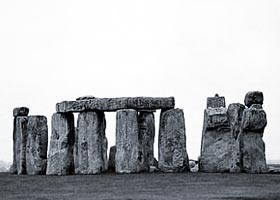Neolithic Architecture Causewayed Camps
Stonehenge The History of Neolithic Architecture
The History of Neolithic Architecture is both mysterious and awe inspiring. Neolithic Architecture is where we can start the history of British Castles! Massive Stone Monoliths such as Stonehenge, and other Stone Circles, were built. Neolithic architecture made use of large stones called Megaliths which weighed up to 4 tons and the amazing Trilithons which weighed about 45 tons! Neolithic Architecture also saw the emergence of Stone Age Causewayed Camps. Neolithic Causewayed Camps were built built on hilltops and consisted of a central ritual area which was surrounded by several concentric, or spiral, rings of banks and ditches. The means of crossing the ditches, or defences, were by several causeways ( raised roadways ) hence the name of 'Causewayed Camps'! Ditch Rings were built and used for funeral customs. Our ideas about Neolithic Architecture move from uncivilised cave dwellers to great builders, architects and engineers who built massive structures which still have the power to amaze modern man! Neolithic Architecture - Time
Time is an important factor in Neolithic architecture: - Social and cultural change?
- Neolithic Architecture, especially in respect of the Causewayed Camps, reflected the social changes of people - living in permanent settlements and the domestication of animals and crops
- The Neolithic Monoliths reflected the cultural requirements of the era - sacred monument built for meetings and religious purposes
- Ditch Rings which were built to accommodate funeral customs
- Changing needs of the population?
- The Neolithic population had moved to permanent living areas - the Neolithic Architecture of the Causewayed Camps. Used as meeting places, trading, animal compounds and defence from intruders. A safe retreat against intrusion or invasion from other Neolithic, or Stone Age, tribes
- What materials were readily available for Neolithic Architecture?
- Stone was the predominant and lasting material
- Were the materials easily accessible?
- No! Stone was moved from quarries which were often miles away from the original site
- How would the materials be transported?
- Stone was moved by river whenever possible ( the River Avon is just two kilometres away from Stonehenge)
- The wheel had not even been invented! Sheer man power was used to pull or drag the huge building stones
- It is possible that Neolithic man waited until the cold winter months when the huge stones could be more easily transported across ice
- What technology, in terms of the building tools, were available?
- Stone tools and flint
- Neolithic cultures made useful stone tools by grinding and polishing relatively hard stones & rocks
- New building techniques, construction methods and ideas
- Stonehenge says it all in terms of Neolithic Architecture!
- The Skills available? The Workforce?
- Many skills were required - building, stone cutting, transportation, organising resources etc. To build the monoliths would have taken a labour force of thousands - mostly slaves!
The answers to these basic questions relating to Neolithic architecture provide a historical doorway into past cultures and eras. |

